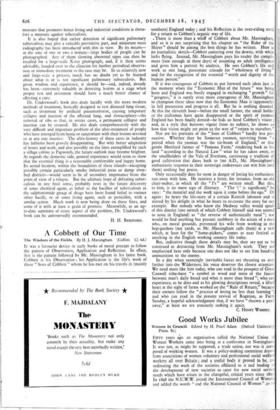The Problem of Tuberculosis
A Manual of Tuberculosis. By E. Ashworth Underwood, M.D., D.P.H. (E. and S. Livingstone, Ltd 15s.) FORTUNATELY, during the last fifty years, there has been a steady decline in this country of illness and death due to tuberculosis, and particularly to pulmonary tuberculosis. There was an exacerbation during the war of 1914-18, and, as was to be expected, an exacerba- tion during the war just over, although to a considerably less extent. This decrease has probably been due to a number of factors, better housing, less overcrowding, better wages, better food, better and much more long-distance accommodation for sufferers, earlier and more certain diagnosis by means of radiological and bacterial ex- amination, and possibly a slowly increasing and more widely diffused degree of immunity against the tubercle bacillus in the population as a whole. But tuberculosis, and especially pulmonary tuberculosis, still ranks as one of the major causes of illness and premature death ; and Dr. Underwood's book—a revised and timely third edition—is designed to give the fullest information not only to doctors them- selves, but to all who are engaged or interested in the campaign to prevent and ultimately destroy it.
As regards prevention, the greater reliance must at present be placed on social measures. Though tuberculosis affects all classes in the community, the sedentary and the athletic, the well-to-do and the poor, all large-scale observations have demonstrated a definite relation in its incidence with income. It is relatively more prevalent in lower income groups than in higher ; and an active case of pulmonary tuberculosis is more likely to infect others in cramped and overcrowded surroundings. Further, while adult pulmonary tuberculosis may be the result of direct infection from another person, it may also be due to the re-awakening of some earlier, latent childhood focus as the result of a general lapse in physical health : and this may be a consequence of fatigue due to overwork or some other illness, or to lack of enough total or suitable food. Any
measure that promotes better living and industrial conditions is there- fore a measure against tuberculosis. It is also hoped that earlier detection of significant pulmonary tuberculosis may play a valuable preventive part, and miniature mass radiography has been introduced with this in view. By its means— at the rate of one or two a minute—large bodies of people can be photographed. Any of them showing abnormal signs can then be recalled for a large-scale X-ray photograph, and, if it then seems advisable, handed over to the clinician for further periodical observa- tion or immediate treatment as the case may be. In so relatively new and large-scale a process, much has no doubt yet to be learned about what is or is not significant pulmonary tuberculosis. But given wisdom and experience, it should be—and, indeed, already has been—extremely valuable in detecting lesions at a stage when proper rest and treatment should have a much better chance of effecting a cure. Dr. Underwood's book also deals lucidly with the more modern methods of treatment, basically designed to rest diseased lung tissue, such as treatment by artificial pneumothorax, causing temporary collapse and inaction of the affected lung, and thoracoplastythe removal of ribs so that, in severe cases, a permanent collapse and inaction can be secured. He also deals comprehensively with the very difficult and important problem of the after-treatment of people who have emerged from home or sanatorium with their lesions arrested or at any rate inactive. The after-history of these cases in industry has hitherto been gravely disappointing. But with better adaptation of hours and work, and also possibly on the lines exemplified by such a village colony as Papworth, the future outlook may become brighter. As regards the domestic side, general experience would seem to show that the essential thing is a reasonably comfortable and happy home. Its actual location, within the boundaries of these islands—excepting possibly certain particularly smoky industrial areas or damp river- bed districts—would seem to be of secondary importance from the point of view of a relapse. But the ultimate hope of defeating tuber- culosis in • any final sense, probably rests in the future discovery of some chemical agent, as lethal to the bacillus of tuberculosis as the sulphonamide group of drugs have been found lethal to various other bacilli, or of some living agent, such as penicillin, with a similar action. Much work is now being done on these lines, and some of it with at least a grain of promise. Meanwhile, as an up- to-date summary of every aspect of the problem, Dr. Underwood's book can be unreservedly recommended.
H. H. BASHFORD.































 Previous page
Previous page